Integra DSX-3 User Manual

> Before Start > Part Names > Install > Initial Setup > Playback
AV Receiver
DSX-3
Instruction
Manual
Supplementary information | Advanced Setup | Others
Before Start |
|
What's in the box .................................................................... |
2 |
Part Names |
|
Front Panel ............................................................................. |
3 |
Rear Panel .............................................................................. |
4 |
Remote Controller .................................................................. |
5 |
Display .................................................................................... |
6 |
Install |
|
1. Speaker Layout .................................................................. |
7 |
2. Connect the Speakers ...................................................... |
12 |
3. Connect the TV ................................................................. |
14 |
4. Connect the HDMI AV Components ................................. |
15 |
5. Connect the Audio Components ....................................... |
16 |
6. Connect Other Cables ...................................................... |
17 |
Initial Setup |
|
Initial Setup with Auto Start-up Wizard ................................. |
18 |
Playback |
|
AV Component Playback ...................................................... |
21 |
Internet Radio ....................................................................... |
22 |
Spotify ................................................................................... |
24 |
Music Server ......................................................................... |
25 |
USB Storage Device ............................................................. |
27 |
AirPlay® ................................................................................ |
29 |
BLUETOOTH® Playback ...................................................... |
30 |
Listening to the FM Radio ..................................................... |
31 |
Listening Modes ................................................................... |
32 |
Quick Menu .......................................................................... |
50 |
Other Functions .................................................................... |
52 |
Supplementary information |
|
Supplementary information for player functions.................... |
53 |
Advanced Setup |
|
Setup Menu........................................................................... |
54 |
Control Function Settings...................................................... |
68 |
Firmware Update .................................................................. |
69 |
Others |
|
Troubleshooting .................................................................... |
72 |
General Specifications .......................................................... |
77 |
About HDMI .......................................................................... |
79 |
License and Trademark Information ..................................... |
80 |

> Before Start > Part Names > Install > Initial Setup > Playback
What's in the box
Main unit (1)
Remote controller (RC-936R) (1), batteries (AAA/R03) (2)
Speaker setup microphone (1)
Indoor FM antenna (1)
2
Supplementary information | Advanced Setup | Others
Power cord (1)
0Connect speakers with 4 Ω to 8 Ω impedance.
0The power cord must be connected only after all other cable connections are completed.
0We will not accept responsibility for damage arising from the connection of equipment manufactured by other companies.
0Functionality may be introduced by firmware updates and service providers may cease services, meaning that some network services and content may become unavailable in the future. Furthermore, available services may vary depending on your area of residence.
0Specifications and appearance are subject to change without prior notice.
0We plan to provide support for the Dolby Atmos and DTS:X audio format through a firmware update for this unit. Refer to our website for more information.
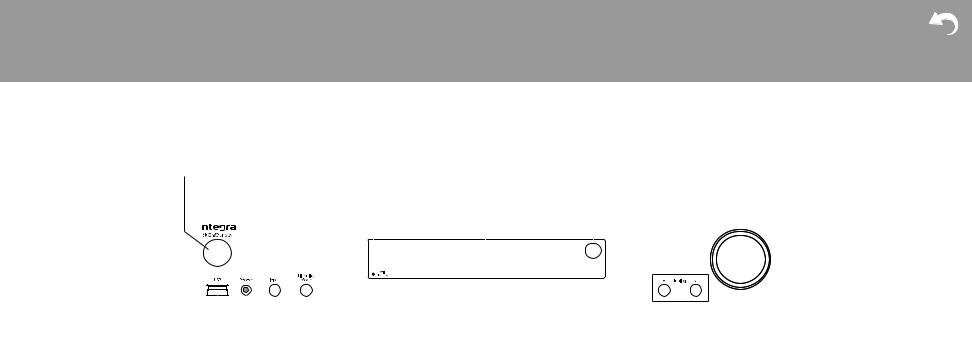
> Before Start > Part Names > Install > Initial Setup > Playback
Supplementary information | Advanced Setup | Others
Front Panel
|
|
|
|
|
|
|
|
|
||||||||||||
|
|
|
|
|
|
|
|
|
|
|
|
|
|
|
|
|
|
|
|
|
|
|
|
|
|
|
|
|
|
|
|
|
|
|
|
|
|
|
|
|
|
|
|
|
|
|
|
|
|
|
|
|
|
|
|
|
|
|
|
|
|
|
|
|
|
|
|
|
|
|
|
|
|
|
|
|
|
|
|
|
|
|
|
|
|
|
|
|
|
|
|
|
|
|
|
|
|
|
|
|
|
|
|
|
|
|
|
|
|
|
|
|
|
|
|
|
|
|
|
|
|
|
|
|
|
|
|
|
|
|
|
|
|
|
|
|
|
|
|
|
|
|
|
|
|
|
|
|
|
|
|
|
|
|
|
|
|
|
|
|
|
|
|
|
|
|
|
|
|
|
|
|
|
|
|
|
|
|
|
|
|
|
|
|
|
|
|
|
|
|
|
|
|
|
|
|
|
|
|
|
|
|
|
|
|
|
|
|
|
|
|
1.Í On/Standby button: Turns the unit on or into standby mode.
2.Hybrid Standby indicator: Lights if the unit enters standby mode when the features are enabled that continue to work when this unit is in standby, such as HDMI Standby Through and Network Standby.
3.Display (P6)
4.Remote control sensor
5.Volume dial: Allows you to adjust the volume.
6.USB port: A USB storage device is connected so that music files stored in it can be played. You can also supply power (maximum 5 V/1 A) to USB devices with a USB cable.
7.Phones jack: Stereo headphones with a mini plug (φ3.5 mm) are connected.
8.Input button: Switches the input to be played. (BD/DVD / CBL/SAT / GAME / STRM BOX / CD / TV / PHONO / FM / NET / USB / BLUETOOTH)
9.Listening Mode button: Allows you to select the listening mode. (P32)
10.Tuning4 3buttons: Select the frequency of FM radio stations.
3

> Before Start > Part Names > Install > Initial Setup > Playback
Supplementary information | Advanced Setup | Others
Rear Panel
|
|
|
|
|
|
|
|
|
|
|
|
|
|
|
|
|
|
|
|
90° |
|
|
|
|
|
|
|
1.TUNER FM 75Ω jack: Connect the supplied antenna.
2.Wireless antenna: Raise for Wi-Fi connection or when using a BLUETOOTH enabled device. The diagram shows the movable range for the wireless antenna. Do not try to force it beyond this range otherwise you may break it.
3.AUDIO IN jacks: Input TV or AV component audio signals with an analog audio cable.
4.GND terminal: The ground wire of the turntable is connected.
5.DIGITAL IN OPTICAL/COAXIAL jacks: Input TV or AV component digital audio signals with a digital optical cable or digital coaxial cable.
6.IR IN jack: Allows you to connect a multiroom remote control kit.
7.SETUP MIC jack: The supplied speaker setup microphone is connected.
8.AC INLET: The supplied power cord is connected.
9.ETHERNET port: Connect to the network with an Ethernet cable.
10.HDMI OUT jack: Connect a HDMI cable to transfer video signals and audio signals to a TV.
11.HDMI IN jacks: Input video signals and audio signals with a HDMI cable connected to an AV component.
12.SPEAKERS terminals: Connect speakers or passive subwoofers with speaker cables. 13.SUBWOOFER PRE OUT jack: Connect a powered subwoofer with a subwoofer cable.
4
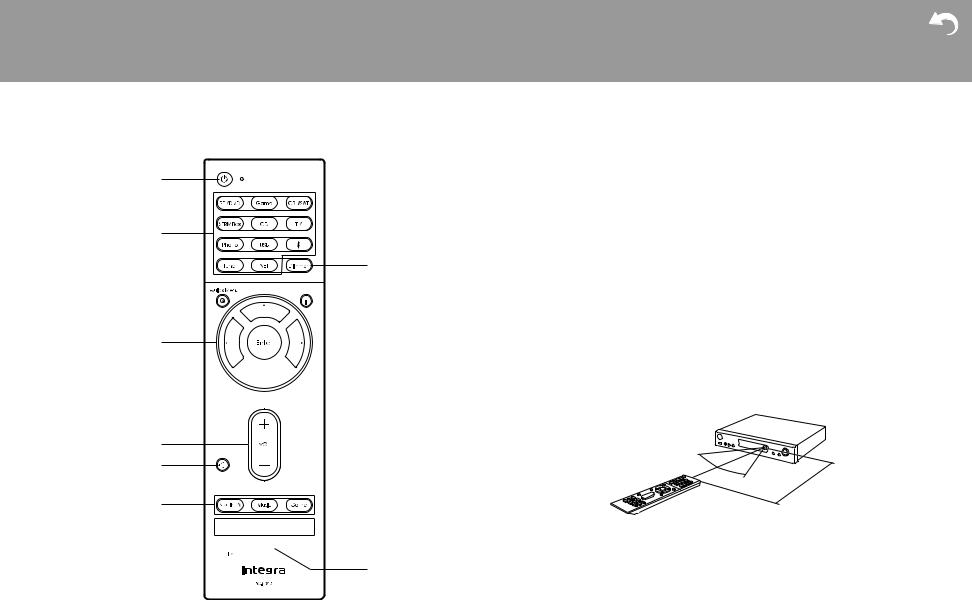
> Before Start > Part Names > Install > Initial Setup > Playback
Supplementary information | Advanced Setup | Others
Remote Controller














1.Í button: Turns the unit on or into standby mode.
2.Input selector buttons: Switches the input to be played.
3.Q (Quick Menu) button: You can perform common settings on the TV screen. (P50)
4.Cursors, Enter button: Select the item with the cursors and press Enter to confirm.
5. button: Displays the Setup menu. (P54)
button: Displays the Setup menu. (P54)
6.Volume buttons: Allows you to adjust the volume. This button also cancels the muting.
7. button: Temporarily mutes audio. Press again to cancel muting.
button: Temporarily mutes audio. Press again to cancel muting.
8.Listening mode buttons: Allows you to select the listening mode. (P32)
9.Play buttons: You can start play of the Music Server or USB.
10.
 button: You can start repeat or random play of the Music Server or USB. Clear button: Deletes all characters you have entered when entering text on the TV screen.
button: You can start repeat or random play of the Music Server or USB. Clear button: Deletes all characters you have entered when entering text on the TV screen.
11.Dimmer button: You can adjust the brightness of the display in three steps. It cannot be turned off completely.
12. button: Switches the information on the display.
button: Switches the information on the display.
13. button: Returns the display to the previous state during setting.
button: Returns the display to the previous state during setting.
14.Mode button: Switches tuning to an FM station between automatic tuning and manual tuning.
15.Memory button: Used to register FM radio stations.
30°
30°
Approx.5 m (16 ft.)
5
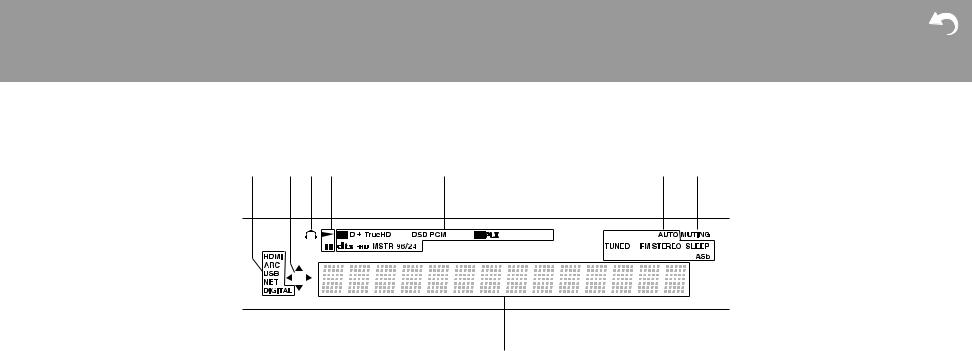
> Before Start > Part Names > Install > Initial Setup > Playback
Supplementary information | Advanced Setup | Others
Display
|
|
|
|
Neo:6
1.Lights in the following conditions.
HDMI: HDMI signals are input and selected.
ARC: Audio signals from the ARC compatible TV are input and selected.
USB: When "USB" is selected with the input selector and the unit is connected by USB and the USB device is selected. Flashes if the USB is not properly connected.
NET: When "NET" is selected with the input selector and the unit is connected to the network. It will flash if the connection to the network is not correct.
DIGITAL: Digital signals are input and the digital input selector is selected.
2.Lights when operating the "NET" or "USB" input selector indicating remote controller cursor operations are possible in screens showing list of tracks, for example.
3.Lights when headphones are connected.
4.Lights when operating the "NET" or "USB" input selector when tracks are played or paused.
5.Lights according to the type of input digital audio signals and the listening mode.
6.Lights in the following conditions. AUTO: When tuning mode is auto. TUNED: Receiving FM radio.
FM STEREO: Receiving FM stereo. SLEEP: Sleep timer has been set.
ASb: When Auto Standby function is enabled. (P65)
6
7.Flashes when muting is on.
8.Displays various information of the input signals. Characters that cannot be displayed on this unit are replaced with asterisks ( ).
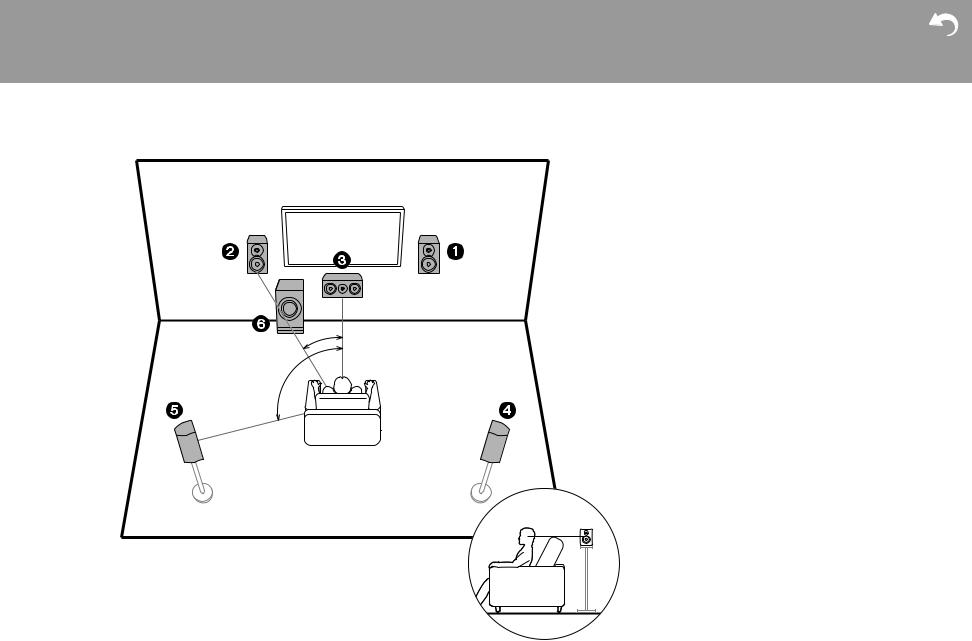
> Before Start > Part Names > Install > Initial Setup > Playback
1. Speaker Layout
1
2
1: 22e to 30e, 2: 120e
Supplementary information | Advanced Setup | Others
5.1 Channel System
Front speakers output front stereo sound and the center speaker outputs sounds emanating from the center of the screen, such as dialog and vocals. Surround speakers create the sound field at the rear. The powered subwoofer reproduces bass sounds and enriches the sound field. The optimal positioning for front speakers is at ear height, and for surround speakers it is just above ear height. The center speaker should be set up at an angle to face the listening position. Placing the powered subwoofer between the center speaker and a front speaker gives you a natural sound even when playing music.
1,2 Front Speakers
3 Center Speaker
4,5 Surround Speakers
6Powered Subwoofer
7
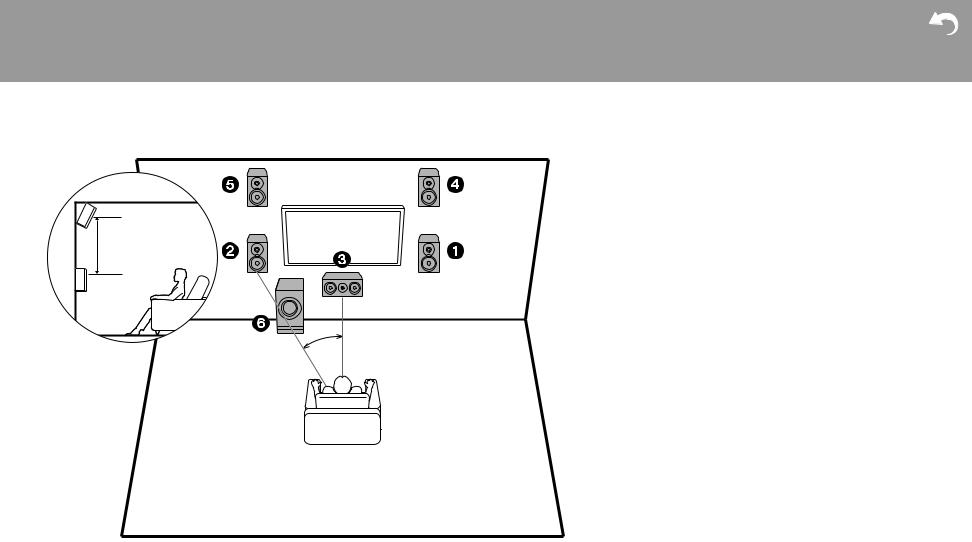
> Before Start > Part Names > Install > Initial Setup > Playback
Supplementary information | Advanced Setup | Others
|
3.1.2 Channel System-1 |
|
|
(Front High Speakers) |
|
|
This is a 3.1-channel system consisting of front speakers, a |
|
|
center speaker, and a powered subwoofer, with the addition |
|
|
of front high speakers, a type of height speaker. Front high |
|
3´ (0.9 m) |
speakers should be situated at least 3y/0.9 m higher than |
|
the front speakers. They should also be put directly above |
||
or more |
the front speakers, angled to face the listening position. |
|
|
0 We plan to provide support for the Dolby Atmos audio |
|
|
|
format through firmware updates for this unit. After this |
|
|
firmware update, by installing height speakers, you can |
|
|
select the Dolby Atmos listening mode, which realizes the |
1 |
|
most up-to-date 3D sound including overhead sounds, |
|
when the input format is Dolby Atmos. Visit our website |
|
|
|
for details about firmware updates. |
|
1,2 Front Speakers |
|
|
3 |
Center Speaker |
|
4,5 Front High Speakers |
|
|
6 |
Powered Subwoofer |
1: 22e to 30e
8
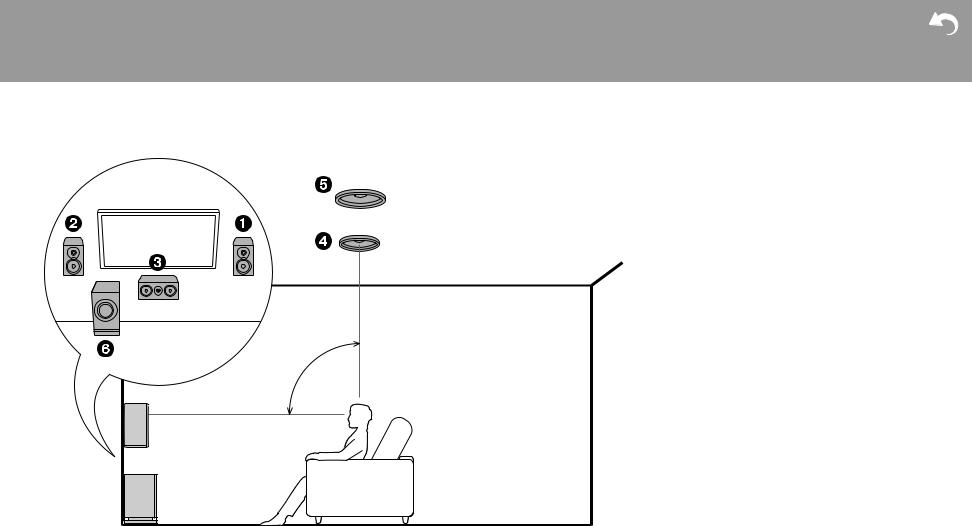
> Before Start > Part Names > Install > Initial Setup > Playback
1
1: 65e to 100e
Supplementary information | Advanced Setup | Others
3.1.2 Channel System-2
(Ceiling Speakers)
This is a 3.1-channel system consisting of front speakers, a center speaker, and a powered subwoofer, with the addition of top middle speakers, a type of height speaker. Fit top middle speakers on the ceiling directly above the listening position. The distance between each pair should match the distance between the two front speakers.
0We plan to provide support for the Dolby Atmos audio format through firmware updates for this unit. After this firmware update, by installing height speakers, you can select the Dolby Atmos listening mode, which realizes the most up-to-date 3D sound including overhead sounds, when the input format is Dolby Atmos. Visit our website for details about firmware updates.
0Dolby Laboratories recommends placing this type of height speakers to obtain the best Dolby Atmos effect.
1,2 Front Speakers
3Center Speaker
4,5 Top Middle Speakers
6Powered Subwoofer
9
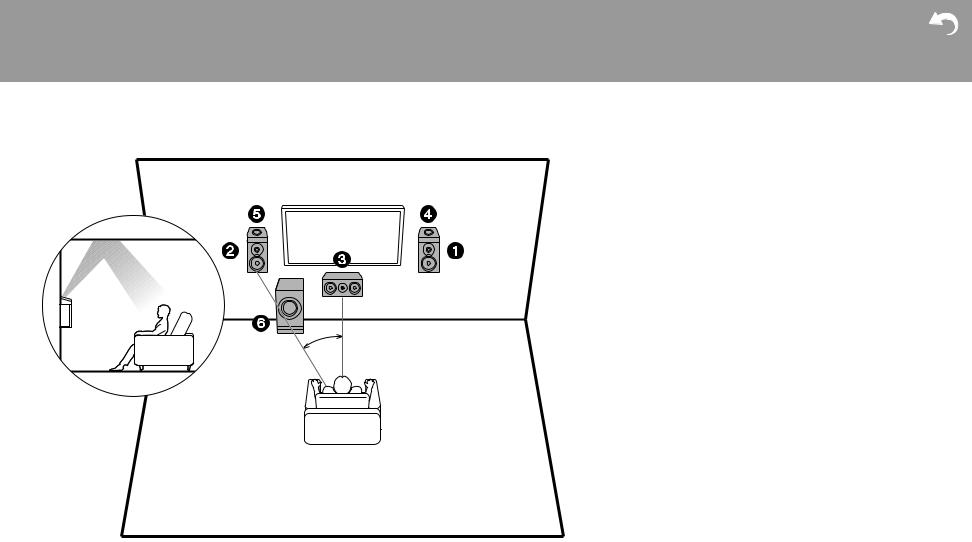
> Before Start > Part Names > Install > Initial Setup > Playback
1
1: 22e to 30e
10
Supplementary information | Advanced Setup | Others
3.1.2 Channel System-3
(Dolby Enabled Speakers (Dolby Speakers))
This is a 3.1-channel system consisting of front speakers, a center speaker, and a powered subwoofer, with the addition of Dolby enabled speakers (front), a type of height speaker. Dolby enabled speakers are special speakers designed to face the ceiling so that sound is heard after bouncing off the ceiling so that sound appears to be coming from overhead. Place Dolby enabled speakers (front) above the front speakers.
0We plan to provide support for the Dolby Atmos audio format through firmware updates for this unit. After this firmware update, by installing height speakers, you can select the Dolby Atmos listening mode, which realizes the most up-to-date 3D sound including overhead sounds, when the input format is Dolby Atmos. Visit our website for details about firmware updates.
1,2 Front Speakers
3Center Speaker
4,5 Dolby Enabled Speakers (Front)
6Powered Subwoofer

> Before Start > Part Names > Install > Initial Setup > Playback
Supplementary information | Advanced Setup | Others
Speaker combinations
Speaker Channels |
FRONT |
CENTER |
SURROUND |
HEIGHT |
2.1 ch
3.1 ch
4.1 ch
5.1 ch
2.1.2 ch
3.1.2 ch
11
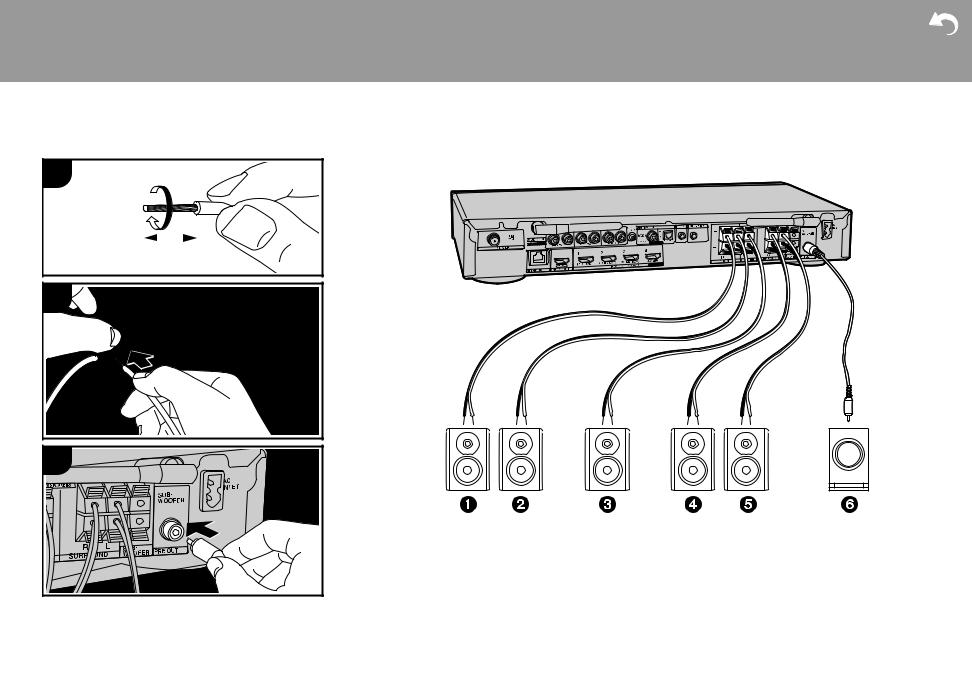
> Before Start > Part Names > Install > Initial Setup > Playback
Supplementary information | Advanced Setup | Others
2. Connect the Speakers
1 |
|
|
a |
|
|
1/2˝ |
|
|
(12 mm) |
|
|
2 |
|
|
|
a |
|
a |
|
|
3 |
|
|
b |
Connect the speakers |
|
|
Refer to the illustration to connect the speaker system. |
|
|
Twist the wires of the speaker cable tightly before inserting |
|
|
into the SPEAKERS terminals. Make correct connection |
|
|
between the unit’s jacks and speaker’s jacks (i to i and j |
|
|
to j) for each channel. If connection is wrong, a bass |
|
a Speaker cable, b Subwoofer cable |
sound may become poor due to reverse phase. |
|
Either a powered subwoofer or passive subwoofer may be |
||
|
b
connected. To connect a powered subwoofer, use a subwoofer cable and connect to the SUBWOOFER PRE OUT jack. To connect a passive subwoofer, connect to the SPEAKERS terminals with speaker cables as shown below.
12

> Before Start > Part Names > Install > Initial Setup > Playback
Supplementary information | Advanced Setup | Others
Make sure the exposed wires of the speakers do not stick out of the speaker terminals when connecting. If the exposed wires of the speakers touch the rear panel or the + and – wires touch each other, the protection circuit will be activated. (P72)
Setup
0Settings for the speaker configuration you have connected need to be made in "1. AccuEQ Room Calibration" (P19) in Initial Setup.
13
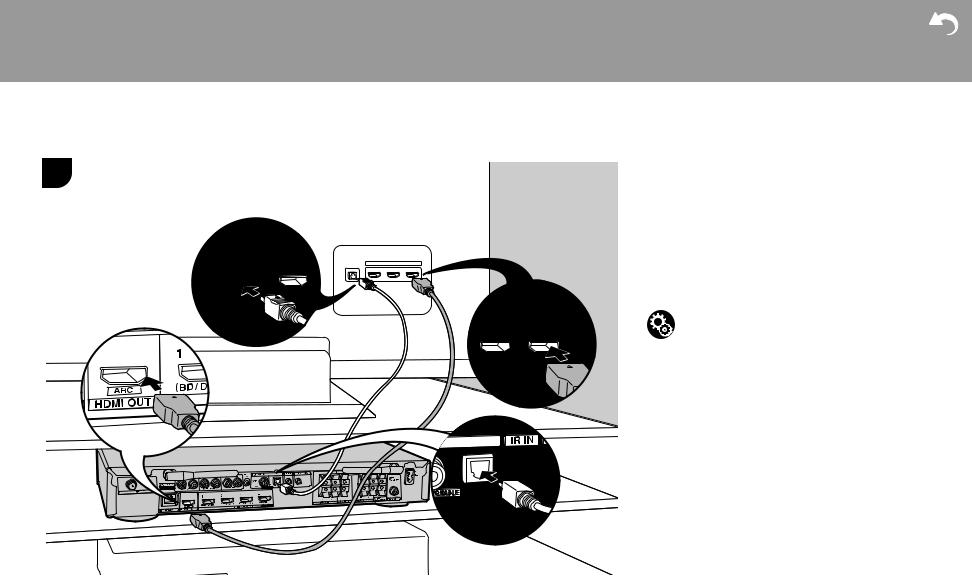
> Before Start > Part Names > Install > Initial Setup > Playback
Supplementary information | Advanced Setup | Others
3. Connect the TV
1
DIGITAL
OPTICAL OUT
To ARC TV
For a TV that supports the ARC (Audio Return Channel) (P79) feature, use an HDMI cable and connect according to illustration "a". Choose an HDMI IN jack on the TV that supports ARC when connecting.
To Non-ARC TV
For a TV that does not support the ARC (Audio Return Channel) feature, connect both the HDMI cable in illustration "a" and the digital optical cable in "b".
b
a HDMI cable, b Digital optical cable
14
Setup
0 Settings are required to use the ARC function. Select
"Yes" in "4. Audio Return Channel" (P20) in the Initial
Setup.
0Please refer to the TV’s operation manual for directions on connections and setup for the TV.
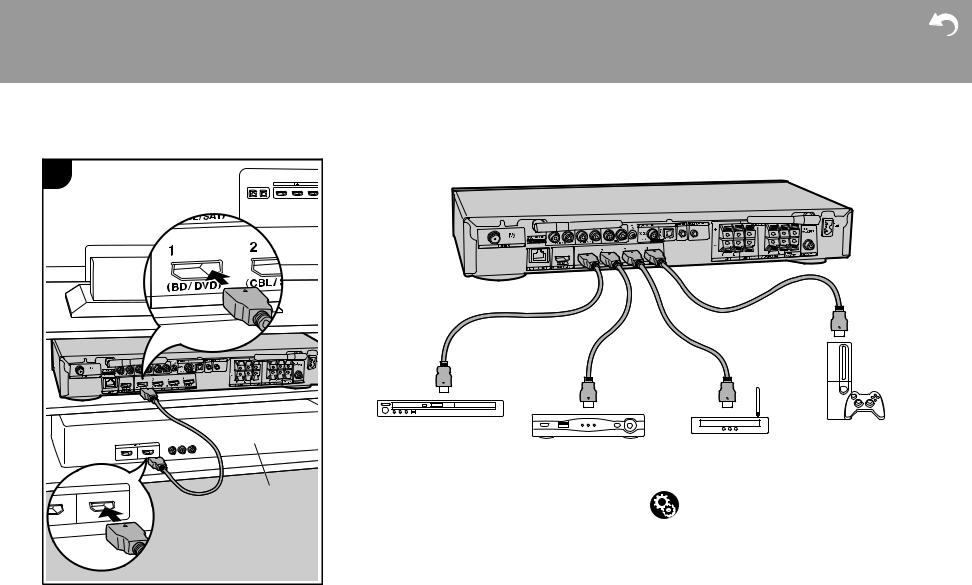
> Before Start > Part Names > Install > Initial Setup > Playback
Supplementary information | Advanced Setup | Others
4. Connect the HDMI AV Components
1 |
|
HDMI OUT |
e.g. BD |
|
a HDMI cable
a
BD/DVD
Cable/Satellite set-top box
This is an example of connection with an AV component that has an HDMI jack. With connection to an AV component that conforms with the CEC (Consumer Electronics Control) standard, you can use features such as the HDMI CEC feature that links with the input selector, and the HDMI Standby Through feature which allows you to play video and audio from AV components on the TV even when this unit is in standby mode. (P79)
0To play 4K or 1080p video, use the high speed HDMI cable.
GAME
Streaming media player
Setup
0 Settings are required to use the HDMI CEC and HDMI Standby Through features. (P62) Make settings after all connections are complete.
0To enjoy digital surround sound including Dolby Digital, audio output should be set to "Bitstream output" on the connected Blu-ray Disc player or other device.
15

> Before Start > Part Names > Install > Initial Setup > Playback
Supplementary information | Advanced Setup | Others
5. Connect the Audio Components
Connecting a CD player
Use a digital coaxial cable to connect a CD player to the
DIGITAL IN COAXIAL jack.
Connecting a turntable
You can also connect a turntable that has an MM-type cartridge to the PHONO jack.
0 If the turntable has a built-in audio equalizer, connect it to an AUDIO IN jack other than the PHONO jack. Further, if the turntable uses an MC type cartridge, install an audio equalizer compatible with the MC type cartridge between the unit and the turntable, then connect to any AUDIO IN jack other than the PHONO jack.
If the turntable has a ground wire, connect it to the GND terminal of this unit.
CD
Turntable
a Digital coaxial cable, b Analog audio cable
16

> Before Start > Part Names > Install > Initial Setup > Playback
Supplementary information | Advanced Setup | Others
6. Connect Other Cables
1 |
2 |
Antenna Hookup |
Connect the supplied FM indoor antenna to the TUNER FM |
||
|
|
75Ω terminal. Move the FM indoor antenna around while |
|
|
playing the radio to find the position with the best reception. |
a |
Network Hookup |
|
Connect this unit to the network using wired LAN or Wi-Fi |
||
|
(wireless LAN). You can enjoy network features such as |
|
|
internet radio by connecting the unit to the network. If you |
|
b |
connect by wired LAN, connect with an Ethernet cable to the |
|
|
ETHERNET port as shown in the illustration. To connect by |
|
|
Wi-Fi, then after selecting "Wireless" in "3. Network |
|
|
Connection" (P20) in Initial Setup, select the desired |
|
3 |
setting method and follow the onscreen instructions to |
|
configure the connection. |
||
|
||
|
Power Cord Hookup |
|
|
This unit includes a removable power cord. Connect the |
|
c |
power cord to the power outlet after completing all other |
|
connections. Connect the power cord to AC INLET of the |
||
c |
unit and then connect to the outlet. Always disconnect the |
|
outlet side first when disconnecting the power cord. |
||
a FM indoor antenna, b Ethernet cable, c Power cord |
|
17

> Before Start > Part Names > Install > Initial Setup > Playback
Supplementary information | Advanced Setup | Others
Initial Setup with Auto Start-up Wizard
1 |
2 |
Initial Setup starts automatically |
1. Switch the input on the TV to that assigned to the unit. |
||
|
|
2. Put batteries into the remote controller of this unit. |
|
|
3. Press Í on the remote controller. When power is turn on |
|
|
for the first time, an Initial Setup screen is automatically |
|
|
displayed on the TV to allow you to make settings |
|
|
required for start up. |
|
|
Initial Setup |
|
|
Language Select |
|
|
English |
|
|
Deutsch |
|
|
Français |
|
|
Español |
|
|
Italiano |
|
|
Nederlands |
|
|
Svenska |
|
|
Русский язык |
|
|
|
|
|
Exit |
|
TV's remote controller |
3 |
4 |
4.Follow the on-screen instructions to select the item with the cursors of the remote controller and press Enter to
confirm your selection.
0 To return to the previous screen, press  .
.
To redo Initial Setup: If you terminate the procedure on the way or want to change a setting made during Initial Setup, press  on the remote controller, select "6. Miscellaneous" - "Initial Setup" in the Setup menu and press Enter. To select the language displayed again, change "OSD Language".
on the remote controller, select "6. Miscellaneous" - "Initial Setup" in the Setup menu and press Enter. To select the language displayed again, change "OSD Language".
(P54)
18

> Before Start > Part Names > Install > Initial Setup > Playback
Supplementary information | Advanced Setup | Others
1. AccuEQ Room Calibration
Place the supplied speaker setup microphone in the listening position, measure the test tones emitted by the speakers, then the unit automatically sets the optimum volume level for each speaker, the crossover frequencies, and the distance from the listening position. This also automatically adjusts the equalizers for the speakers and enables correction of distortion caused by the acoustic environment of the room.
0Calibration takes between 3 to 12 minutes to be completed. The speakers emit the test tone at high volume during measurement, so be careful of your surroundings. Keep the room as quiet as possible during measurement.
0If the power of this unit suddenly turns off, the wires in the speaker cables may have touch the rear panel or other wires and tripped the protection circuit. Twist the wires again properly and make sure they do not stick out of the speaker terminals when connecting.
1.Place the supplied speaker setup microphone in the listening position, and connect to the SETUP MIC jack on the main unit.
SETUP MIC
When putting the speaker setup microphone on a tripod, refer to the illustration when putting it in place.
0To cancel AccuEQ Room Calibration partway through, disconnect the speaker setup microphone.
2.Select the connected speaker configuration.
AccuEQ Room Calibration
Speaker Channels |
5.1 ch < > |
|
|
Subwoofer |
Yes |
|
|
Height Speaker |
--- |
|
|
|
|
||
|
|
|
|
Select how many speakers you have.
Next
The image on the screen changes as you choose the number of channels in "Speaker Channels", so refer to it when performing the settings. Also use this screen to select whether you have connected a subwoofer.
0If you have connected a subwoofer, check the power and volume of the subwoofer. The low frequencies played by the subwoofer may not be discernible, so set its volume to at least halfway.
3.Test tones are emitted by the speakers, and firstly the unit detects the speakers connected and the noise in the environment.
4.After the results of the above measurements are displayed, select "Next", press Enter on the remote controller, and the test tones are emitted again, and the unit automatically makes settings such as the optimum volume level and the crossover frequency.
5.When the measurement is completed, the measurement result is displayed.
Press the cursors / on the remote controller to check the settings. Press Enter when "Save" is selected to save the settings.
AccuEQ Room Calibration
Review Crossover |
|
Subwoofer |
: Yes |
Front |
: 100Hz |
Center |
: 100Hz |
Surround |
: 100Hz |
Save
Cancel
6.Select whether to enable or disable the equalizer function that corrects for distortion caused by the acoustic environment of the room.
AccuEQ Room Calibration
To enable equalizer for each speakers, select "On".
Please select "All Channels", if you have same speakers for all channels. Please select "Except Front Left / Right", if front speakers are larger than other speakers.
On (All Channels)
On (Except Front Left / Right)
Off
Next
If this is to be enabled, then normally you should select "On (All Channels)", and to disable just the front speakers you should select "On (Except Front Left / Right)".
7.Disconnect the speaker setup microphone.You cannot use any other menu options while it is connected.
2.Source Connection
Check that each input source is connected correctly. Follow the guidance, select the input you want to confirm, start play of the selected player, and confirm that the images appear on the TV and that sound is played.
19

> Before Start > Part Names > Install > Initial Setup > Playback
3. Network Connection
Set up Wi-Fi connection with an access point such as a wireless LAN router. There are the following two methods of connecting by Wi-Fi:
"Scan Networks": Search for an access point from this unit. Find out the SSID of the access point beforehand.
"Use iOS Device (iOS7 or later)": Share the iOS device's Wi-Fi settings with this unit.
If you select "Scan Networks", there are a further two choices of connection method. Check the following.
0"Enter Password": Enter the password (or key) of the access point to connect.
0"Push Button": If the access point has an automatic connection button, you can connect without entering a password.
0If the SSID of the access point is not displayed, then in the screen listing the SSIDs, select "Other..." with the button on the remote controller and press Enter, then follow the on-screen instructions.
Wi-Fi Setup
Рбуучптд
a b c d e |
f |
g |
h |
i j k l |
m |
|
|
|
|
|
|||
n o p q r s t |
u v w x y |
z |
||||
1 2 3 4 5 |
6 7 8 |
9 0 - ^ |
\ |
|||
, . / ; : |
@ |
[ |
] |
|
|
|
|
A/a |
|
|
|
OK |
|
When finished, select the "OK" key.
 All Erase
All Erase  Hide/Show
Hide/Show  A/a
A/a
Keyboard input: To switch between upper and lower case, select "A/a" on the screen and press Enter. To select whether to mask the password with " " or display it in plain text, press Memory on the remote controller. Pressing Clear will delete all the input characters.
Privacy policy: A confirmation screen asking you to agree to the privacy policy is displayed during network setting. Select "Yes" and press Enter to indicate agreement.
20
Supplementary information | Advanced Setup | Others
4. Audio Return Channel
If you have connected a TV that supports ARC, select "Yes". This unit's ARC setting turns on and you can listen to the TV's audio through this unit.
0If you select "Yes", the HDMI CEC function is enabled and power consumption increases during standby.
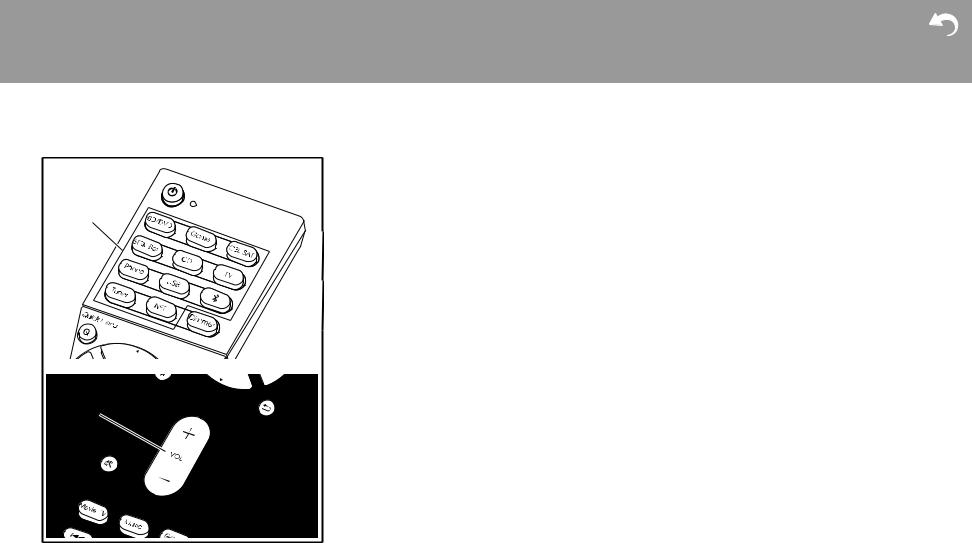
> Before Start > Part Names > Install > Initial Setup > Playback
Supplementary information | Advanced Setup | Others
AV Component Playback
a
b
Basic operations
Play an AV component or TV connected to this unit with an
HDMI cable or other cable.
1.Switch the input on the TV to that assigned to the unit.
2.Press the input selector (a) on the remote controller with the same name as the jack to which you connected the player to switch the input.
For example, press BD/DVD to play the player connected to the BD/DVD jack. Press TV to listen the TV's sound. 0 Note that when the CEC link function works, the input switches automatically when you have connected a CEC compliant TV and player to this unit using HDMI
connection.
3.Start play on the player.
4.Use VOL+/– (b) to adjust the volume.
21

> Before Start > Part Names > Install > Initial Setup > Playback
Supplementary information | Advanced Setup | Others
Internet Radio
1
a
b
 c
c
Basic operations
When this unit is connected to a network, you can listen to TuneIn or other preregistered Internet radio services. Depending on the internet radio service, the user may need to register from their computer first.
1.Switch the input on the TV to that assigned to the unit.
2.Press NET on the remote controller.
3. Follow the on-screen instructions, using the cursors to select radio stations and programs, then press Enter (b) to play. Play starts when 100% is displayed for buffering. 0 To return to the previous screen, press  (c).
(c).
0If you cannot select a network service, it will become selectable when the network function is started.
Regarding the TuneIn Radio
To display the TuneIn Radio menu during play, press Enter
(b) on the remote controller.
Add to My Presets: Registers radio stations being broadcast and programs in "My Presets". Once registered, "My Presets" is displayed in the level under TuneIn Radio. To play, select the program you like from "My Presets".
Remove from My Presets: Removes a radio station or program from "My Presets" in TuneIn Radio.
Pandora®
Pandora is a free, personalized Internet radio service that plays the music you know and helps you discover music you’ll love. After selecting "Pandora", do the following.
1.Use / (a) on the remote controller to select "I have a Pandora Account" or "I’m new to Pandora" and then press Enter (b).
If you are new to Pandora, select "I’m new to Pandora". You will see an activation code on your TV screen. Please write down this code. Go to an Internet connected computer and point your browser to www.pandora.com/ integra. Enter your activation code and then follow the instructions to create your Pandora account and your personalized Pandora stations. You can create your stations by entering your favorite tracks and artists when
prompted. After you have created your account and stations you can return to your receiver and press Enter
(b) to begin listening to your personalized Pandora. If you have an existing Pandora account, you can add your Pandora account to your receiver by selecting "I
have a Pandora Account" and logging in with your email and password.
2.To play a station, use / (a) on the remote controller to select the station from your station list, and then press Enter (b). Playback starts and the playback screen appears.
Create new station: Enter the name of a track, artist, or genre and Pandora will create a unique radio station for you based on the musical qualities of that track, artist, or genre.
Regarding the Pandora Menu: Icons are displayed on the screen while playing a station. You can do the following by selecting the icon with / (a) on the remote controller and pressing Enter (b).
 (I like this track) :
(I like this track) :
Give a track "thumbs-up" and Pandora will play more music
22

> Before Start > Part Names > Install > Initial Setup > Playback
Supplementary information | Advanced Setup | Others
like it.
 (I don't like this track) :
(I don't like this track) :
Give a track "thumbs-down" and Pandora will ban that track from the current station.
 :
:
Automatically find stations matching your preferences based on genre, specific artists, and songs, and delete those stations you don't need.
23

> Before Start > Part Names > Install > Initial Setup > Playback
Supplementary information | Advanced Setup | Others
Spotify
1 |
|
Basic operations |
|
|
Spotify Connect play is possible by connecting this unit to |
||
Wi-Fi |
|
the same network as a smart phone or tablet. To enable |
|
|
Spotify Connect, install the Spotify application on your |
||
|
smartphone or tablet and create a Spotify premium account. |
||
|
|
1. Connect the smartphone to the network that this unit is |
|
|
|
connected to. |
|
|
|
2. Click the Connect icon in the track play screen of the |
|
|
|
Spotify app. |
|
2 |
a |
3. Select this unit. |
|
4. This unit turns on automatically and the input selector |
|||
|
|
changes to NET and streaming of Spotify starts. |
|
|
|
0 If "5. Hardware" - "Power Management" - "Network |
|
|
|
Standby" is set to "Off" in the Setup menu, manually turn |
|
|
|
the unit on and then press NET on the remote controller. |
|
|
|
0 Refer to the following for Spotify settings: |
|
|
b |
www.spotify.com/connect/ |
|
|
|
0 The Spotify software is subject to third party licenses |
|
3 |
c |
found here: |
|
www.spotify.com/connect/third-party-licenses |
|||
|
|
|
|
The following remote controller operations are also |
|
d |
possible. |
|
(a)Pressed during play, this button changes the displayed |
|
|
|
|
|
|
track information. |
|
|
(b)This button plays the previous track. |
|
|
(c) This button lets you start repeat or random playback. |
e |
|
Pressing this button repeatedly cycles through the |
4 |
|
repeat modes. |
|
(d)Pressed during play this button pauses playback. |
|
|
Pressed while paused, and it restarts play. |
|
IntegraDSX-3 |
|
(e)This button plays the next track. |
|
|
24

> Before Start > Part Names > Install > Initial Setup > Playback
Supplementary information | Advanced Setup | Others
Music Server
1
a
b
c
 d
d
e
f

 g
g
h
It is possible to stream music files stored on PCs or NAS devices connected to the same network as this unit. The network servers this unit is compatible with are those PCs with players installed that have the server functionality of Windows Media® Player 11 or 12, or NAS that are compatible with home network functionality. You may need to make some settings in advance to use Windows Media® Player 11 or 12. Note that only music files registered in the library of Windows Media® Player can be played.
Configuring Windows Media® Player
■ Windows Media® Player 11
1.Turn on your PC and start Windows Media® Player 11.
2.In the "Library" menu, select "Media Sharing" to display a dialog box.
3.Select the "Share my media" check box, and then click "OK" to display the compatible devices.
4.Select this unit, click "Allow" and put a check mark next to the icon for this unit.
5.Click "OK" to close the dialog.
0Depending of the version of Windows Media® Player, there may be differences in the names of items you can select.
■ Windows Media® Player 12
1.Turn on your PC and start Windows Media® Player 12.
2.In the "Stream" menu, select "Turn on media streaming"
to display a dialog box.
0If media streaming is already turned on, select "More streaming options..." in the "Stream" menu to list players
in the network, and then go to step 4.
3.Click "Turn on media streaming" to list players in the network.
4.Select this unit in "Media streaming options" and check that it is set to "Allow".
5.Click "OK" to close the dialog.
0 Depending of the version of Windows Media® Player,
there may be differences in the names of items you can select.
Playing
1.Start the server (Windows Media® Player 11, Windows Media® Player 12, or NAS device) containing the music files to play.
2.Make sure that the PCs and/or NASs are properly connected to the same network as this unit.
3.Switch the input on the TV to that assigned to the unit.
4.Press NET on the remote controller.
5.With the cursors on the remote controller, select "Music Server", and then press Enter (b).
6.Select the target server with the cursors on the remote controller and press Enter (b) to display the items list screen.
7.With the cursors on the remote controller, select the music file to play, and then press Enter (b) to start
playback. To return to the previous screen, press  (d).
(d).
0If "No Item." is displayed, check whether the network is properly connected.
0Depending on the server and share settings, the unit may not recognize it, or may not be able to play its music files. Furthermore, the unit cannot access pictures and videos stored on servers.
0For music files on a server, there can be up to 20,000 tracks per folder, and folders may be nested up to 16 levels deep.
25
